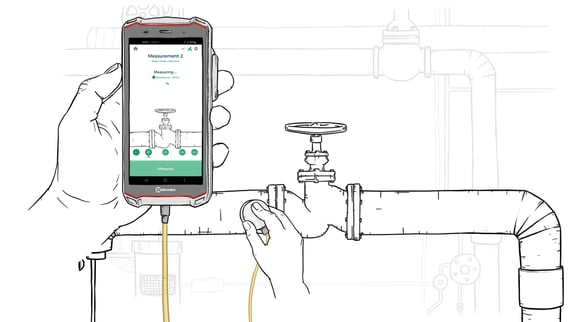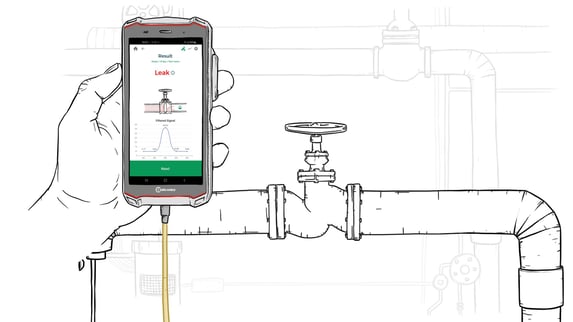
In the world of industrial valves, maintaining optimal functionality is critical to ensuring smooth operations, avoiding economic losses and protecting employee health and safety. However, studies show that 5-10% of industrial valves leak internally, and leak detection is relatively complex.
A modern but well-established NDT method for inspecting valves for internal leaks is acoustic emission testing. However, existing solutions have some limitations, and interviews with experts performing field inspections have shown that they face challenges such as using the correct measurement points, determining the correct measurement duration, applying the correct pressure when placing the sensor, and finally, transmitting data and interpreting the results. In addition, leak detection currently relies heavily on expert knowledge, such as hearing, vision, and other senses and experience, to assess valve leak detection.
In our research over the last few years, we have therefore identified four key points that we believe are essential/crucial to making valve inspection processes more standardized, faster and more reliable:
-
Standardized data collection
-
A simple inspection process to solve the dependency on pure expert knowledge
-
Digital features for data processing and data interpretation
-
Structured data storage and standardized reporting
1) Standardized data collection
In order to store inspection data in a structured way and analyze trends over time, structured metadata is essential before starting the measurement process. Our approach builds on the use of RFID tags or predefined input masks. This simplifies handling for the user, as the data only needs to be entered once and is later automatically recognized by the system or can be retrieved by scanning the RFID tag. At the same time, it ensures that different inspections for the same valve can be assigned in a structured manner.
2) Simple inspection process
As mentioned earlier, conversations with professionals have revealed that they face various challenges, such as the right measurement points, the right measurement duration, the transmission of data and the interpretation of results, etc. With our digitized approach to valve inspection, we try to overcome these challenges by using a software-guided inspection process that leads the user through the measurement process step by step.

3) Digital features for data processing and evaluation
In these times of skills shortages, it is becoming increasingly difficult for companies to rely solely on human expertise. When it comes to valve inspection, the biggest challenge for inspectors is interpreting the measurement data. Specialized training and extensive experience are required to analyze the characteristics of the wave form and evaluate the condition of a material or structure. Moreover, generating reproducible results (objective, not subjective) is a critical component when results depend solely on human expertise.
In recent years, algorithms and artificial intelligence have become powerful tools to overcome this complexity and facilitate the handling of large amounts of data. Several experiments have already been conducted combining artificial intelligence with acoustic emission testing. Our approach is also based on the latest technologies. In addition to state-of-the-art acoustic emission sensors, that can already suppress certain noise, we use signal processing technology to further improve the signal-to-noise ratio and thus the overall accuracy of signal analysis.
To overcome the challenge of interpreting measurement results, detection algorithms are used to accurately identify anomalies and immediately report the user whether a valve is leaking or not.

4) Structured data storage and standardized reporting
To avoid the loss of knowledge and data, we believe that structured data management is necessary for all inspections. With our solution, all inspection data is automatically synchronized in a cloud-based Backoffice where maintenance staff can perform further analysis or automatically generate standardized reports according to ISO. This approach facilitates building a database of a large number of different inspections on critical assets. And helps maintenance management to identify problems early and make appropriate decisions quickly.
If you want to learn more about it and discuss how your inspection processes can become more standardized: get in touch: office@senseven.ai or find more information at www.senseven.ai
Leave Your Comment Here